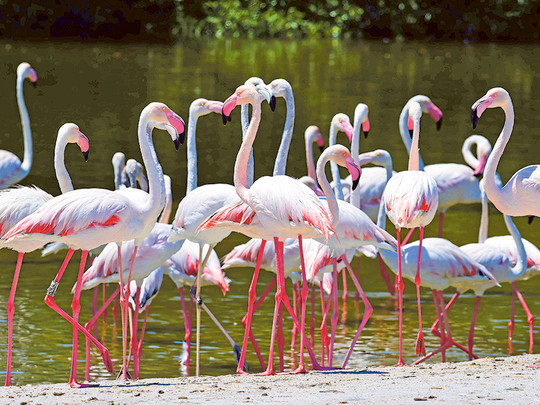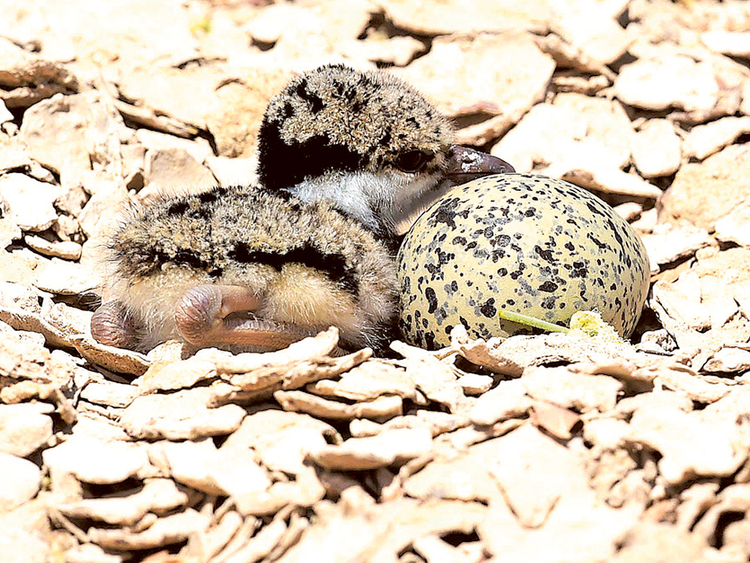
Dubai: Dubai’s strategic location has helped the emirate forge one of the busiest airports in the world, an international crossroads through which millions of passengers migrate to far-flung locales across the globe.
But before giant jet-powered birds streaked trails across the blue yonder, Dubai and the UAE were already an international hub, of sorts, for millions of birds migrating north and south in the annual autumn and summer seasons.
Down through time, the UAE has long been a preferred rest stop for exotic avian world travellers given the country’s rich marine food sources, mudflats, lagoons and sabkha (mud flats) sanctuaries.
Coastal shallows, inland waterways, mangroves and salt marshes are critical layovers for birds fleeing icy snowbound regions of the Asian and Siberian Arctic on their quest to seek warmer climes in Africa.
An estimated three million birds call upon the UAE’s 83,600 square kilometres annually through four aerial flight corridors which form part of what’s called the Palaearctic-Asian Flyway.
To pay homage to one of the greatest natural marvels in the world, wildlife experts, ornithologists and amateur birdwatchers in the UAE are expected to fan out to important bird areas across the country on May 10 to observe World Migratory Bird Day.
The event is held every year to boost awareness of “migratory birds, their ecological importance, and the need for international cooperation to conserve them”, said event organisers.
This year’s theme is ‘Stop the illegal killing, taking and trade of migratory birds’.
Dr Reza Khan, principal wildlife specialist, Dubai Zoo/Safari, Dubai Municipality, told Gulf News that ensuring UAE’s wildlife areas are protected is pivotal to provide migrating flocks sanctuary on their multi-continent sojourns every year.
Extensive conservation measures to protect one of Dubai’s most well-known bird areas, Ras Al Khor Wildlife Sanctuary, is a good example of responsible environmental stewardship by UAE government officials committed to helping migrating flocks.
Over the years, covered public viewing areas known as blinds or hides have been constructed in the Ras Al Khor watershed to witness with minimal interference migrating birds in the thousands such as the Greater Flamingo, the elegant pink birds which blanket the creekside marsh as part of their many hops every year.
Click to view infographic.
The sanctuary is protected and is recognised as one of 19 “important bird areas” in the UAE under the Ramsar Convention, signed by the UAE in 2007, a global intergovernmental treaty.
“One of the best places and most easily accessible places of the UAE is the Ras Al Khor Wildlife Sanctuary,” said Khan in an interview. “During autumn and spring passage migration time, it is not unlikely to see nearly 10,000 waders roosting here. The Abu Dhabi coast and some islands supports over 100,000 birds at a time during summer migration.”
The flamingoes are only a few of the wild passengers taking a rest in Dubai, he said.
“Birds that pass through the UAE in the thousands include almost all species of small and big-sized waders such as plovers, stints, snipes, sandpipers, godwits, curlews, whimbrels, turnstones, ruffs, all species of gulls barring the Sooty Gull that is partly resident and mostly migratory, ducks, teals, Great Cormorant and terns,” Khan said.
Despite coastal development throughout the Gulf, UAE’s protection measures combined with awareness measures such as World Migratory Bird Day are helping to offset myriad threats to flocks ranging from water pollution, habitat loss, power lines, hunting, and harvesting.
As part of his conservation work, Khan said he is “involved in the Red Listing process of the International Union for the Conservation of Nature (Iucn) that declares which animals are threatened or not around the world. Also, locally, I do study migratory birds and other animals
“Unless we know which animals pass through our area or which ones are resident, we cannot have any wildlife conservation policy or programme for a nation or a department or organisation of country,” he said.
The UAE is doing all that it can to reduce impact on migrating birds, he said.
“Airports in many countries take note of the movement of birds in the neighbourhood and restrict the flight movement or avoid the bird movement routes. Once, in 1984, a large flock of white storks landed in Abu Dhabi airport and it was closed for few hours,” he said.
“Dubai has also stopped dumping organic waste at Jebel Ali waste site because thousands of gulls were roosting there and would come in the way of the landing and take-off of aircraft from the would-be airport. Organic waste dumps can attract anywhere from 2,000 to nearly 100,000 gulls and some terns.”
Khan said he is working on a new inland project near the existing Al Qudra Lake to create a protected water body that will provide yet another rest stop for migrating birds. The project is still under construction and is not open to the public.
World Migratory Bird Day 2016 organisers said this year’s global effort includes 2,000 bird day events in 135 countries to raise awareness of dwindling bird populations.
“Avian migration is a natural miracle. Migratory birds fly hundreds and thousands of kilometres to find the best ecological conditions and habitats for feeding, breeding and raising their young. When conditions at breeding sites become unfavourable, it is time to fly to regions where conditions are better,” said the event’s spokesman. “Migration is a perilous journey and involves a wide range of threats, often caused by human activities. And as diverse as people and their habits in different countries are, so are threats the birds face. As migratory birds depend on a range of sites along their distribution area, the loss of wintering and stopover sites could have a dramatic impact on the birds’ chances of survival.”
Another hurdle faced by migrating birds is a patchwork of wildlife protection measures by different countries along flyways.
“Flying long distances involves crossing many borders between countries with differing environmental politics, legislation and conservation measures. It is evident that international cooperation among governments, NGOs and other stakeholders is required along the entire flyway of a species in order to share knowledge and to coordinate conservation efforts,” said the spokesperson.













